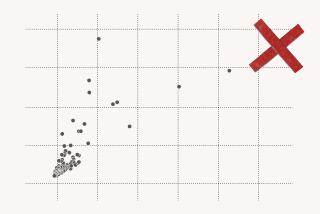Medical response time lags in many pricey L.A. neighborhoods
Waits for 911 medical aid vary dramatically across Los Angeles and many of the city’s most exclusive neighborhoods have the longest response times, according to a Times investigation.
Under national standards adopted by the Los Angeles Fire Department, rescuers are supposed to arrive within six minutes to almost all medical emergencies. But the Times analysis found that in affluent hillside communities stretching from Griffith Park to Pacific Palisades, firefighters failed to hit that mark nearly 85% of the time.
In contrast, rescuers beat the six-minute standard in most of their responses in the more densely populated neighborhoods in and around downtown, where 911 calls are more frequent and the department deploys more resources.
The disparities were also seen in cases of cardiac arrest, one of the most time-sensitive emergencies; brain damage can begin just four minutes after the heart stops beating. Over the last five years, cardiac arrest responses to incidents in Bel-Air have been twice as long as those in the Westlake neighborhood surrounding MacArthur Park, where rescuers arrived on average in just over five minutes.
The Fire Department’s 911 response record is being closely scrutinized by auditors, fire commissioners and elected officials. In March, top commanders acknowledged the agency had for years been producing performance reports that overstated how quickly rescuers were reaching victims in need.
The Times investigation is the first independent, block-by-block analysis of how long it takes LAFD units to reach victims after the agency picks up a 911 call. The findings reinforce the obvious risks of living in L.A.’s scenic and desirable canyon enclaves, where wildfires and mudslides are a perennial concern and narrow and winding roads can slow rescue vehicles.
Battalion Chief Armando Hogan, a spokesman for the Fire Department, said rescuers do their best to get to patients as quickly and safely as possible. But he said difficult driving conditions in the mountains make that a challenge. “There’s so many blind spots it’s ridiculous,” Hogan said. “Not a lot we can do about that.”
Bel-Air residents Joe and Wanda Miller know how frustrating and frightening the long waits can be.
Last November, Joe, 84, had to wait more than 14 minutes for rescuers to come after Wanda, 86, passed out. She survived, but it was the fifth time the couple had called 911 in recent years. Each time, they waited more than 13 minutes for LAFD rescuers to arrive, records show.
“It’s the hills. Just try to get around these curves,” said Joe, who said the couple are thinking about leaving their sprawling, white-columned home to be closer to help.
The city’s 469 square miles are protected by 106 firehouses, with deployment plans based on population and call load. As a result, some LAFD stations serve larger areas than others. A few cover swaths of sparsely populated territory larger than entire cities. The firehouse responsible for portions of Bel-Air and Brentwood, for example, serves an area nearly twice as large as the city of Santa Monica, which has four fire stations.
Fire Chief Brian Cummings has said the department would need to nearly double its stations and staff to meet national response time standards everywhere in the city.
Battalion Chief Trevor Richmond, who oversees the unit responsible for deployment, said, “We’d all like to have an unlimited amount of money and have a fire station on every corner.
“That would be the ideal situation,” Richmond said. “But we know that’s not reality.”
Since questions arose about response times earlier this year, initial reform efforts supported by Mayor Antonio Villaraigosa and his Fire Commission have focused on calculating reliable citywide averages. A report released Wednesday by a task force appointed by the Fire Commission found the average response time for calls in September was 6 minutes and 47 seconds.
But the Times investigation, which mapped out more than 1 million dispatches since 2007, found those broad performance measures mask stark disparities in emergency response times that have grown longer in recent years amid budget cuts.
The analysis found that the longest responses often occur when an area’s primary rescue units are on other calls or are out of service, creating holes in coverage. Citywide, the first unit to reach victims in medical emergencies came from a more distant station at least 15% of the time, the analysis found.
The effect is less pronounced in areas with a high concentration of fire stations, The Times analysis found.
But coverage gaps regularly created long delays in parts of the city with fewer stations, including in the east San Fernando Valley, the southern edge of Playa del Rey and some neighborhoods in the Santa Monica Mountains.
In Bel-Air, rescuers failed to meet the six-minute response time standard nearly 90% of the time, in part because more distant rescuers had to be dispatched in hundreds of 911 calls.
In those cases, they took nearly 11 1/2 minutes on average to reach those needing medical help.
Department officials acknowledged “simultaneous incidents” are a vexing issue and difficult to manage in some parts of the city with current staffing levels.
That alarms Haldis Toppel, a Pacific Palisades resident who last year rallied her neighbors in a failed bid to save a local fire engine that was taken out of service. The cutback was part of a round of budget reductions that shuttered units at more than one-fifth of the city’s stations.
“It’s a very dangerous situation,” Toppel said. If remaining local units are busy, she said, “we may be cut off totally without any backup.”
Firefighter Steve Tufts, who has worked in Pacific Palisades, said “that’s where the big response times come in.”
The agency is experimenting with a pilot project that has put five firefighters on motorcycles to speed up response times, including in hillside communities. Officials hope to find funding to make it permanent, but note that motorcycle rescuers carry only a limited amount of medical supplies and must wait for ambulances to transport victims to hospitals.
Officials also want to install GPS devices in every rescue unit so dispatchers know where units are at all times. Similar technology has helped speed responses in other jurisdictions, including Honolulu, studies show.
Battalion Chief Richmond said he does not expect the department to make significant changes to its current deployment plan, such as adding more staff or stations in hillside areas, any time soon. That means that people like Adria August may continue to wait for help.
August lives in a gated community on a secluded hill north of the Getty Center in the Sepulveda Pass. Last year, she waited more than 16 minutes for an ambulance when her husband lost consciousness due to dehydration.
Because the nearest firehouse, Station 109 on Mulholland Drive, did not have a paramedic ambulance, one based nearly five miles away in Sherman Oaks had to be sent, records show.
The wait felt endless, August said. “Even when it’s five minutes, it seems like forever.”
Still, she doesn’t fault the Fire Department. She and her neighbors chose to live in a secluded place, she said. “We bought up here for the quietness, the privacy, the security.”
More to Read
Start your day right
Sign up for Essential California for news, features and recommendations from the L.A. Times and beyond in your inbox six days a week.
You may occasionally receive promotional content from the Los Angeles Times.









